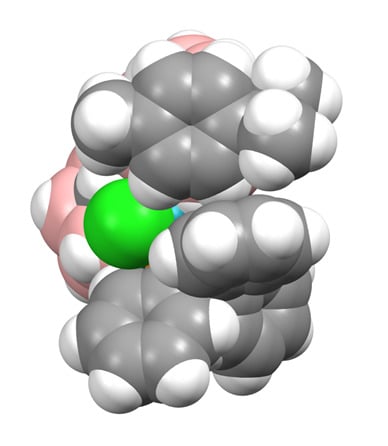Exopolyhedral Ligand Orientation Controls Diastereoisomer in Mixed-Metal Bis(Carboranes) †
Abstract
:1. Introduction
2. Results and Discussion
2.1. Synthesis and Characterisation of Compound 1
2.2. Synthesis and Characterisation of Compounds 2 and 3
2.3. Control of the Diastereoisomeric Nature of Compounds 1 and 2
3. Experimental Section
3.1. General Considerations
3.1.1. Synthesis and Characterisation of [μ7,8-(1′,3′−3′-Cl-3′-PPh3-closo-3′,1′,2′-RhC2B9H10)-2-(p-cymene)-closo-2,1,8-RuC2B9H10] (1)
3.1.2. Synthesis and Characterisation of [μ7,8-(1′,3′−3′-Cl-3′-PPh3-closo-3′,1′,2′-RhC2B9H10)-2-Cp-closo-2,1,8-CoC2B9H10] (2) and [8-{8′-2′-H-2′,2′-(PPh3)2-closo-2′,1′,8′-RhC2B9H10}-2-Cp-closo-2,1,8-CoC2B9H10] (3)
3.2. Crystallographic Studies
4. Conclusions
Supplementary Materials
Author Contributions
Funding
Acknowledgments
Conflicts of Interest
References
- Sivaev, I.B.; Bregadze, V.I. 1,1′-Bis(ortho-carborane)-based transition metal complexes. Coord. Chem. Rev. 2019, 392, 146–176. [Google Scholar] [CrossRef]
- Yruegas, S.; Axtell, J.C.; Kirlikovali, K.O.; Spokoyny, A.M.; Martin, C.D. Synthesis of 9-borafluorene analogues featuring a three-dimensional 1,1′-bis(o-carborane) backbone. Chem. Commun. 2019, 55, 2892–2895. [Google Scholar] [CrossRef] [PubMed]
- Wu, J.; Cao, K.; Zhang, C.-Y.; Xu, T.-T.; Ding, L.-F.; Li, B.; Yang, J. Catalytic Oxidative Dehydrogenative Coupling of Cage B−H/B−H Bonds for Synthesis of Bis(o-carborane)s. Org. Lett. 2019, 21, 5986–5989. [Google Scholar] [CrossRef] [PubMed]
- Jeans, R.J.; Chan, A.P.Y.; Riley, L.E.; Taylor, J.; Rosair, G.M.; Welch, A.J.; Sivaev, I.B. Arene-Ruthenium Complexes of 1,1′-Bis(ortho-carborane): Synthesis, Characterization, and Catalysis. Inorg. Chem. 2019, 58, 11751–11761. [Google Scholar] [CrossRef]
- Thiripuranathar, G.; Man, W.Y.; Palmero, C.; Chan, A.P.Y.; Leube, B.T.; Ellis, D.; McKay, D.; Macgregor, S.A.; Jourdan, L.; Rosair, G.M.; et al. Icosahedral metallacarborane/carborane species derived from 1,1′-bis(o-carborane). Dalton Trans. 2015, 44, 5628–5637. [Google Scholar] [CrossRef] [PubMed] [Green Version]
- Thiripuranathar, G.; Chan, A.P.Y.; Mandal, D.; Man, W.Y.; Argentari, M.; Rosair, G.M.; Welch, A.J. Double deboronation and homometalation of 1,1′-bis(ortho-carborane). Dalton Trans. 2017, 46, 1811–1821. [Google Scholar] [CrossRef]
- Chan, A.P.Y.; Rosair, G.M.; Welch, A.J. Heterometalation of 1,1′-bis(ortho-carborane). Inorg. Chem. 2018, 57, 8002–8011. [Google Scholar] [CrossRef]
- Chan, A.P.Y.; Parkinson, J.A.; Rosair, G.M.; Welch, A.J. Bis(phosphine)hydridorhodacarborane Derivatives of 1,1′-Bis(ortho-carborane) and their Catalysis of Alkene Isomerization and the Hydrosilylation of Acetophenone. Inorg. Chem. 2020. [Google Scholar] [CrossRef]
- Behnken, P.E.; Marder, T.B.; Baker, R.T.; Knobler, C.B.; Thompson, M.R.; Hawthorne, M.F. Synthesis, Structural Characterization, and Stereospecificity in the Formation of Bimetallic Rhodacarborane Clusters Containing Rh-H-B Bridge Interactions. J. Am. Chem. Soc. 1985, 107, 932–940. [Google Scholar] [CrossRef]
- Groom, C.R.; Bruno, I.J.; Lightfoot, M.P.; Ward, S.C. The Cambridge Structural Database. Acta Crystallogr. Sect. B Struct. Sci. Cryst. Eng. Mater. 2016, 72, 171–179. [Google Scholar] [CrossRef]
- Baker, R.T.; Delaney, M.S.; King III, R.E.; Knobler, C.B.; Long, J.A.; Marder, T.B.; Paxson, T.E.; Teller, R.G.; Hawthorne, M.F. Metallacarboranes in Catalysis. 2. Synthesis and Reactivity of Closo Icosahedral Bis(phosphine)hydridorhodacarboranes and the Crystal and Molecular Structures of Two Unusual closo-Phosphinerhodacarborane Complexes. J. Am. Chem. Soc. 1984, 106, 2965–2978. [Google Scholar] [CrossRef]
- McAnaw, A.; Scott, G.; Elrick, L.; Rosair, G.M.; Welch, A.J. The VCD method—A simple and reliable way to distinguish cage C and B atoms in (hetero)carborane structures determined crystallographically. Dalton Trans. 2013, 42, 645–664. [Google Scholar] [CrossRef] [PubMed]
- McAnaw, A.; Lopez, M.E.; Ellis, D.; Rosair, G.M.; Welch, A.J. Asymmetric 1,8/13,2,x-M2C2B10 14-vertex metallacarboranes by direct electrophilic insertion reactions; the VCD and BHD methods in critical analysis of cage C atom positions. Dalton Trans. 2014, 43, 5095–5105. [Google Scholar] [CrossRef] [PubMed] [Green Version]
- Welch, A.J. What can we learn from the crystal structures of metallacarboranes? Crystals 2017, 7, 234. [Google Scholar] [CrossRef]
- Mingos, D.M.P.; Forsyth, M.I.; Welch, A.J. Molecular and Crystal Structure of 3,3-Bis(triethylphosphine)-1,2-dicarba-3-platinadodecaborane and Molecular-orbital Analysis of the “Slip” Distortion in Carbametallaboranes. J. Chem. Soc. Dalton Trans. 1978, 1363–1374. [Google Scholar] [CrossRef]
- Osborn, J.A.; Wilkinson, G.; Mrowca, J.J. Chlorotris(triphenylphosphine)rhodium(I) (Wilkinson’s catalyst). Inorg. Synth. 1990, 28, 77–79. [Google Scholar]
- Sheldrick, G.M. A short history of SHELX. Acta Crystallogr. Sect. A Found. Crystallogr. 2008, 64, 112–122. [Google Scholar] [CrossRef] [Green Version]
- Sheldrick, G.M. Crystal structure refinement with SHELXL. Acta Crystallogr. Sect. C Struct. Chem. 2015, 71, 3–8. [Google Scholar] [CrossRef]
- Dolomanov, O.V.; Bourhis, L.J.; Gildea, R.J.; Howard, J.A.K.; Puschmann, H. OLEX2: A complete structure solution, refinement and analysis program. J. Appl. Cryst. 2009, 42, 339–341. [Google Scholar] [CrossRef]
- Van der Sluis, P.; Spek, A.L. BYPASS: An effective method for the refinement of crystal structures containing disordered solvent regions. Acta Crystallogr. Sect. A Found. Crystallogr. 1990, 46, 194–201. [Google Scholar] [CrossRef]
- Macrae, C.F.; Bruno, I.J.; Chisholm, J.A.; Edgington, P.R.; McCabe, P.; Pidcock, E.; Rodriguez-Monge, L.; Taylor, R.; van de Streek, J.; Wood, P.A. Mercury CSD 2.0—New features for the visualization and investigation of crystal structures. J. Appl. Cryst. 2008, 41, 466–470. [Google Scholar] [CrossRef]






© 2020 by the authors. Licensee MDPI, Basel, Switzerland. This article is an open access article distributed under the terms and conditions of the Creative Commons Attribution (CC BY) license (http://creativecommons.org/licenses/by/4.0/).
Share and Cite
Chan, A.P.Y.; Rosair, G.M.; Welch, A.J. Exopolyhedral Ligand Orientation Controls Diastereoisomer in Mixed-Metal Bis(Carboranes). Molecules 2020, 25, 519. https://0-doi-org.brum.beds.ac.uk/10.3390/molecules25030519
Chan APY, Rosair GM, Welch AJ. Exopolyhedral Ligand Orientation Controls Diastereoisomer in Mixed-Metal Bis(Carboranes). Molecules. 2020; 25(3):519. https://0-doi-org.brum.beds.ac.uk/10.3390/molecules25030519
Chicago/Turabian StyleChan, Antony P. Y., Georgina M. Rosair, and Alan J. Welch. 2020. "Exopolyhedral Ligand Orientation Controls Diastereoisomer in Mixed-Metal Bis(Carboranes)" Molecules 25, no. 3: 519. https://0-doi-org.brum.beds.ac.uk/10.3390/molecules25030519





